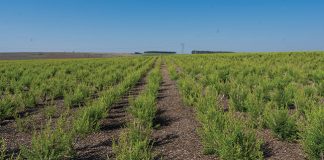Citrus trees are planted in rows in orchards or groves and can take three years to start bearing fruit ready to harvest and sell. Growing citrus is a long-term investment, so it’s a good idea to be informed before undertaking this type of farming. In the next two issues we will look at the climatic, soil and water requirements of citrus, the annual cycle of citrus plants, popular citrus cultivars and harvest periods.
For marketing and production purposes in South Africa, citrus is divided into four main groups – oranges, grapefruit, lemons and soft citrus (eg. mandarins). All citrus contains vitamin C, a water-soluble vitamin with immune-enhancing effects. The Eastern Cape produces the most citrus in South Africa, followed by Limpopo, Mpumalanga, the Western Cape and KwaZulu-Natal. The harvesting season is usually from May to October.
Originating in the tropics, citrus plants are grown worldwide in various climatic zones, but do not tolerate extreme cold. Production in South Africa is confined to areas with mild, virtually frost-free winters and temperatures that seldom drop below -2°C. The average minimum temperature in the coldest month should not be below 2°C to 3°C if the trees are unprotected. Where rainfall is poor, irrigation ensures good growth and production.
Soil requirements
Citrus trees need deep soil with a pH of between 6 and 6,5 and good surface and internal drainage. Surface drainage prevents water settling around the tree, while internal drainage allows water to filter through the soil without saturating the root zone. Look at the area in which you want to establish your orchard. If healthy trees grow there you can assume the soil is suitable for citrus.
To test the internal drainage, dig a post hole about 2m deep and fill it with water. The water should drain from the hole within 24 to 36 hours. Avoid soil that requires more than 48 hours to drain completely.
Water requirements
Water is taken in by soil particles and made available for absorption by the plant’s roots. These normally grow to a depth of 1m and spread up to 2m beyond the tree’s drip line. This is the area defined by the circumference of the canopy where water drips from the leaves onto the ground.
Soil with a layer that restricts drainage becomes saturated or waterlogged. You can identify such a layer by a grey/yellowish-grey colour, or numerous yellow- or reddish-brown splotches. It can also consist of a rock sill or a series of vertical rock joints or blocks. For optimum water provision, ideal citrus soil will have the following characteristics:
- Red, yellow-brown or brown colour.
- Clay content of 10% to 40%.
- No mottled or structured layers within 1m of the soil surface.
These are the general requirements for citrus but much will depend on the type of citrus you intend to grow.
What is citrus?
Citrus trees can vary in height from 5m to 15m. They are evergreen with spiny shoots and green leaves. Depending on the variety, the flowers may occur singly or in branched clusters. Flowers are usually between 2cm and 4cm in diameter with five petals. Citrus fruit has a tough and leathery rind with a juicy interior. Citrus fruit can be eaten fresh, pressed for juice, or preserved in marmalades and pickles.
- In the next issue we’ll look at different varieties and regions where citrus grow best.
- For more information, contact the Citrus Growers’ Association of Southern Africa at 031 765 2514 or email [email protected]
- Sources: Cultivating Citrus, compiled by the Directorate Agricultural Information Services, department of agriculture, in co-operation with the ARC-Institute for Tropical and Subtropical Crops; the Citrus Academy; Citrus Postharvest Series; plantzone.co.za; sunkist.com.













